#SWTech: The Beginnings of an Online Community
In just a few days, Google will eliminate its online community platform, Google+, and with it will go the first iteration of our #SWTech Online Community. This has me thinking about the whys and whats of how our #SWTech community started and developed, and how it will soon evolve. This blog post is my first attempt to chronicle the people and platforms that shaped our community. My methods were simple. I sent emails to some members requesting information, and talked over the phone and video calls with others. I readily acknowledge the bias and poor memory that I bring to this brief and simple historical record. In fact, this was a common theme I heard from others. I think Neil Ballantyne, Senior Lecturer at Open Polytechnic of New Zealand and board member of husITa, said it best when I asked him how he discovered the #SWTech group:
I have absolutely no recollection of this. Memory of internet events is a strange thing. We don’t have the same visceral people or place related indicators that ensure an encounter is stored in long term memory. The answer to this question is lost in the human equivalent of random access memory…but I guess it must have been a Google search, Twitter post or some other fleeting moment of connection.
Neil’s response resonates with me because I don’t remember when I connected with several of the #SWTech members online, but I do remember meeting them in-person after months of exchanging tweets or other digital comments. The concept of Strong-Tie and Weak-Tie Social Connections may shed some light on this experience. Weak-Ties involve limited interaction among people who are mostly acquaintances while Strong-Ties include frequent interaction based on emotional intensity that develop between people who have common attitudes. I think about those of us in academic settings who were interested in technology in social work who connected because we didn’t have support within our departments or institutions. We bonded around the negativity we all experienced from colleagues and professionals who didn’t see the value of technology for social work. Within the context of social media, some communication scholars suggest that Weak-Ties lead to Strong-Ties when interactions between individuals move from online to offline (in-person) encounters. Anecdotally, I heard this theme from several #SWTech members when collecting stories for this post, and observe it every time I’m present to see people from our community meet in real time.
Thus, there will be gaps in this story, but I hope this post will help push the #SWTech community to evolve, innovate, and grow. I also hope people will me fill in the missing peieces of this story.
Forming: The beginnings of #SWTech
We know the #SWTech hashtag came before the Google+ Group. No one I spoke with remembers who first came up with this hashtag, but it looks like Karen Zgoda, Founder of #MacroSW, and Nancy Smyth, Dean of the School of Social Work at University at Buffalo, were some of the first social workers to use it on Twitter almost ten years ago:

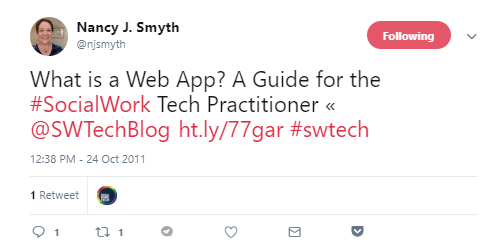
For those of us in social work academics in the United States, Nancy was the one who gave authority and whole lot of street cred to #SWTech. Nancy early involvement in tech began with her work as a doctoral student in the 1985 project Microcomputer Applications in Social Work. In 1991, she co-published an article about what social workers need to know about technology in the journal Computers in Human Services. The rest of us were trying to make technology work in our careers. We followed the hashtag, and sent tweets to each other. Then, we started meeting at academic social work conferences, having a meal or drinks, and talking about the different ways we were using technology. It was really the same old story of networking and making connections; just using different tools. Jimmy Young, Assistant Professor of Social Work at California State University San Marcos remembers meeting Jonathan Singer, founder of The Social Work Podcast and Associate Professor of Social Work at Loyola University Chicago, in 2010, when they first met at a Council on Social Work Education (CSWE) conference, but had already started following Jonathan on Twitter. Ellen Belluomini, Assistant Professor of Social Work at Brandman University and blogger at Bridging the Digital Divide in Social Work Practice, remembers connecting the group the old fashioned way:
I attended the first Social Work Distance Education conference in 2014. At this conference in Indianapolis, a table held sign-up sheets for areas of focus to gather. #SWTech held one of those spots. I met other #SWTechies in person for the first time and my life has not been the same since. Now social work tech can be found through online chats, blogs, conferences, professional organizations, and a plethora of other sources. It is here I found not just ‘a’ community, but ‘my’ community and then ‘our’ community, of social workers dedicated to the future of social work.
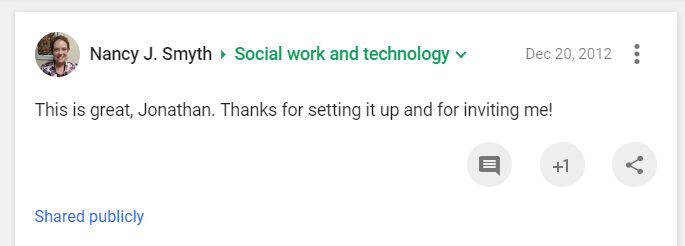
Jonathan created the #SWTech community on Google+ in 2012, as a late night activity, he recalls. Jimmy and Melanie Sage, Assistant Professor of Social Work at the University at Buffalo, were added as moderators of the group. Jimmy remembers being happy to be involved the Google+ group because, through his research, he had come to see and get so much value from connecting with others through social media. Melanie recalls hearing so many of her colleagues say that “technology isn’t a social work thing,” so being a part of the #SWTech community was so important during her early days with as a social work academic.
The Google+ #SWTech Group quickly became a virtual space to share resources, learn about other’s work, and meet new people. Neil told me that #SWTech was one of a number of sources where he could post updates on the work of husITa and learn who was doing what, with whom, where on a number of other social work tech related issues. He said he was most interested in notices of research, publications, and social work tech projects that her learned about from the group.
Storming: Social Work Academics and Practitioners
One of my favorite things about the Google+ #SWTech Group has been the connections I have made with social work practitioners interested in technology. This is how I connected Karen Zgoda, social work practitioner who blogs and is one of the founders of #MacroSW, as well as Elise Johnson, a medical social worker and part-time social work faculty, among many others. Jonathan remembers connecting with Ignacio Pacheco, founder of the blog Social Work Tech.com, and Sean Erregrs, founder of the blog Stuck on Social Work, to learn more about how practitioners were using tech in daily social work practice. Melanie remembers connecting with Ruby Guillen, a social worker specializing in child welfare, about hackathons for social work.
It has also been interesting to observe the classic dynamics of ivory tower compared to those in the trenches play out in the #SWTech community. As a social work academic, it has been easy for me to attend social work conferences to meet other techies, and find resources and time to support social work tech projects. This has not been the case for many of the social work practitioners in #SWTech who devote energy to the community after a full day of work or who scrap together enough to attend a national social work conference on their own because their employer cannot send them.
I don’t have a good answer for this natural tension between practitioners and academics, but I do think the technology tools can help bring us together. One shining example of this is #MacroSW.com, an online community that developed from a Twitter chat into a thriving organization of practitioners and academics working to promote macro social work practice. Please check out their work. I was honored to be #MacroSW Partner from 2015 until 2018.
Another great example is Sean, who blogs, teaches part-time, and encourages other social work practitioners interested technology to participate and perhaps in professional organizations like husITa, Health Information Management and Systems Society, and All Tech is Human. He believes practitioners can be partners with those building technology (i.e. academics, those in other disciplines, etc), especially within the context of one’s practice area. For instance, he wrote an article on how those in #SWTech can interact with those in health information technology.
Norming: Highlights from the Google+ Group
While Twitter has been a consistent way for #SWTech members to communicate with each other, I think the Google+ group has been a way for us to organize around projects. Here are a few examples:
Melanie asked members to create short videos about their best social work technology tip in 2016. Brendan Beal’s video is still a classic.
The #SWTech group crowdsourced feedback for the National Association of Social Workers (NASW) in 2016, when the organization was updating their Standards for Technology in Social Work Practice.
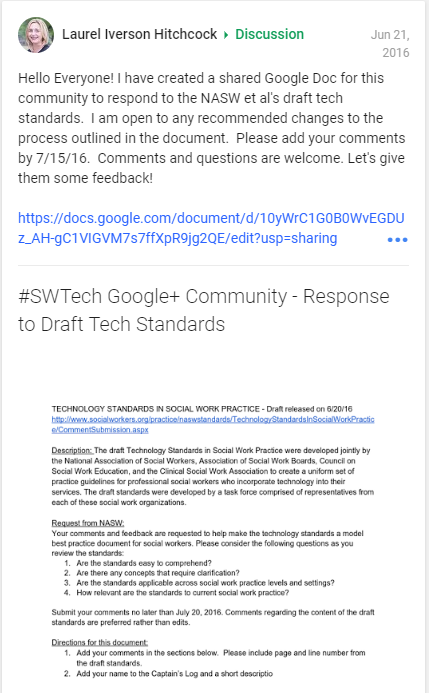
Another highlight from 2016 is when Elise Johnson created and shared one of the first technology assessment tools for working with clients.
Sean promoted the use of new technology tools with the #SWTech group for a regular feature on his blog, Tools for Practice Tuesday.
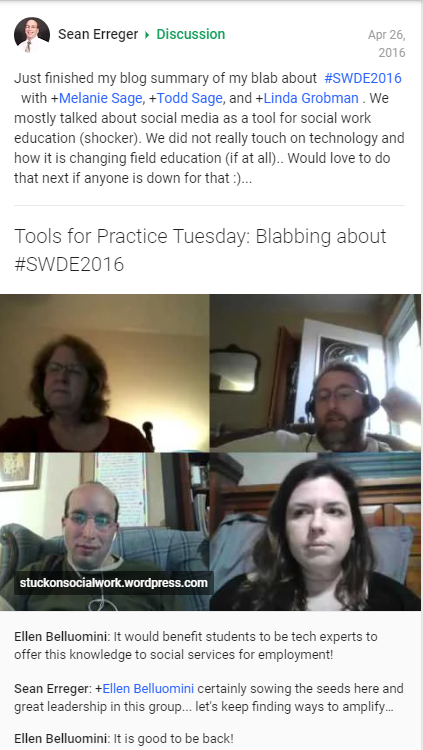
Next Steps
Over time, the Google+ evolved as did #SWTech. Jimmy observed that he moderated posts for Google+ off and on over the years but dramatically slowed his involvement last year when he was mainly only seeing bots and advertisements cross the community. “It was just too much to keep up with,” he said. Jonathan reminded me that #SWTech is not an official group, so there are no rules for who is in and not in the group. He sees this as a limitation for #SWTech, which has become mostly an academic hashtag, and learning how to better engage social work practitioners in #SWTech is clearly a need for our online community. Similarly, Neil sees a need to connect the older #SWTech community with plans for a membership based organization. His vision includes an open community with a core of “strong ties” members (who might be paying members) and “weaker ties” associates who support the organization in other ways.
For now, #SWTech has moved from Google+ to the platform, Mighty Networks. You can sign-up for a free account and then search for Social Work and Technology: https://swtech.mn.co/feed. And you can still follow #SWTech on Twitter. This hashtag is also registered with Symplur’s Healthcare Hashtag Project.
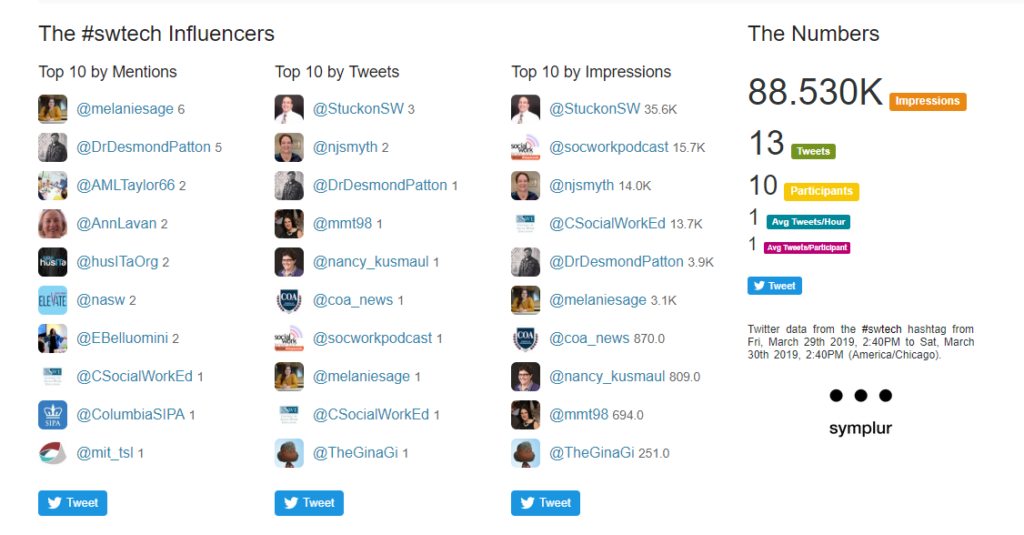
And now, dear #SWTech Community, I ask you to help me tell the rest of the story. Please add your comments to this post about when and how you first connected with #SWTech. For some prompts, please consider the following questions:
- How did you discover #SWTech (on Twitter, Google Plus, etc.)? Why did you want to get involved?
- How did your involvement with #SWTech support your work, efforts or ideas with technology in social work practice or education?
- In your opinion, what does the future hold for #SWTech (i.e. where does the community need to go, consider, etc.)?
- Any other comments or thoughts?
How to Cite this Post:
Hitchcock, L.I. (2019, March 30). #SWTech: The Beginnings of an Online Community [Blog Post]. Retrieved from:
https://laureliversonhitchcock.org/2019/03/31/swtech-the-beginnings-of-an-online-community/

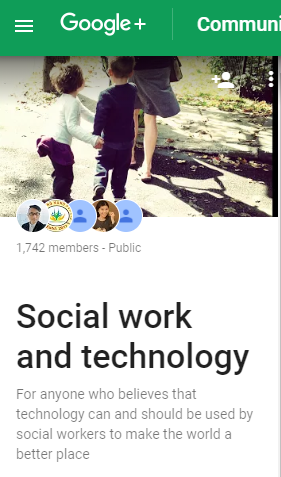
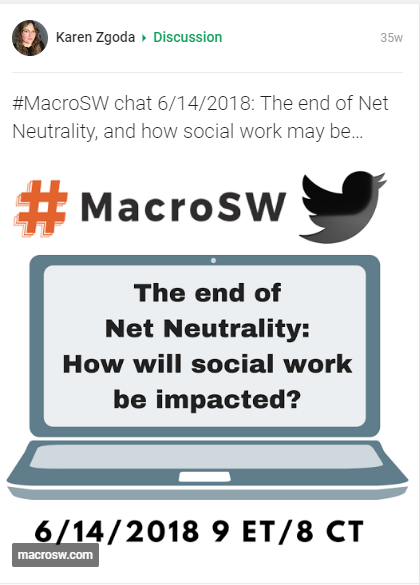
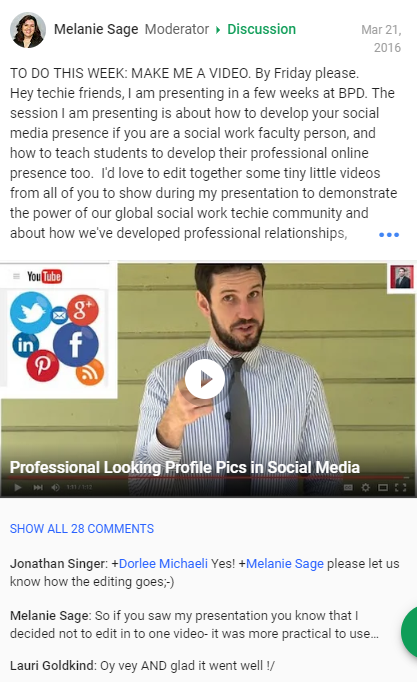
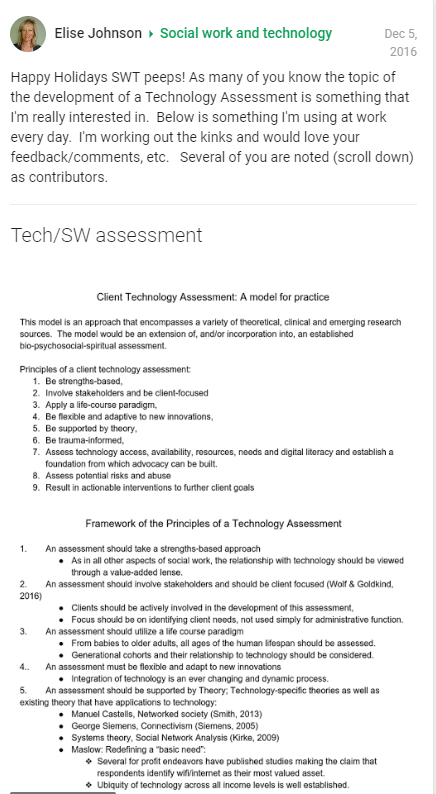


March 31, 2019
I don’t remember exactly how this happened for me, but I was on Twitter in the days when I transitioned from practice to academia. I updated my profile to reflect an interest in technology, and that’s where I started to connect with other #swtech social workers.
I do believe the emergence and strengthening of the #swtech community, via blogs like this one, published articles and time meeting and sharing ideas at conferences, have helped inform my work as a distance education administrator.
Going forward, should the profession of social work continue to move in the direction is appears to me moving, tech will be a natural part of everything social work does. In education, the use of technology in teaching will continue to converge.